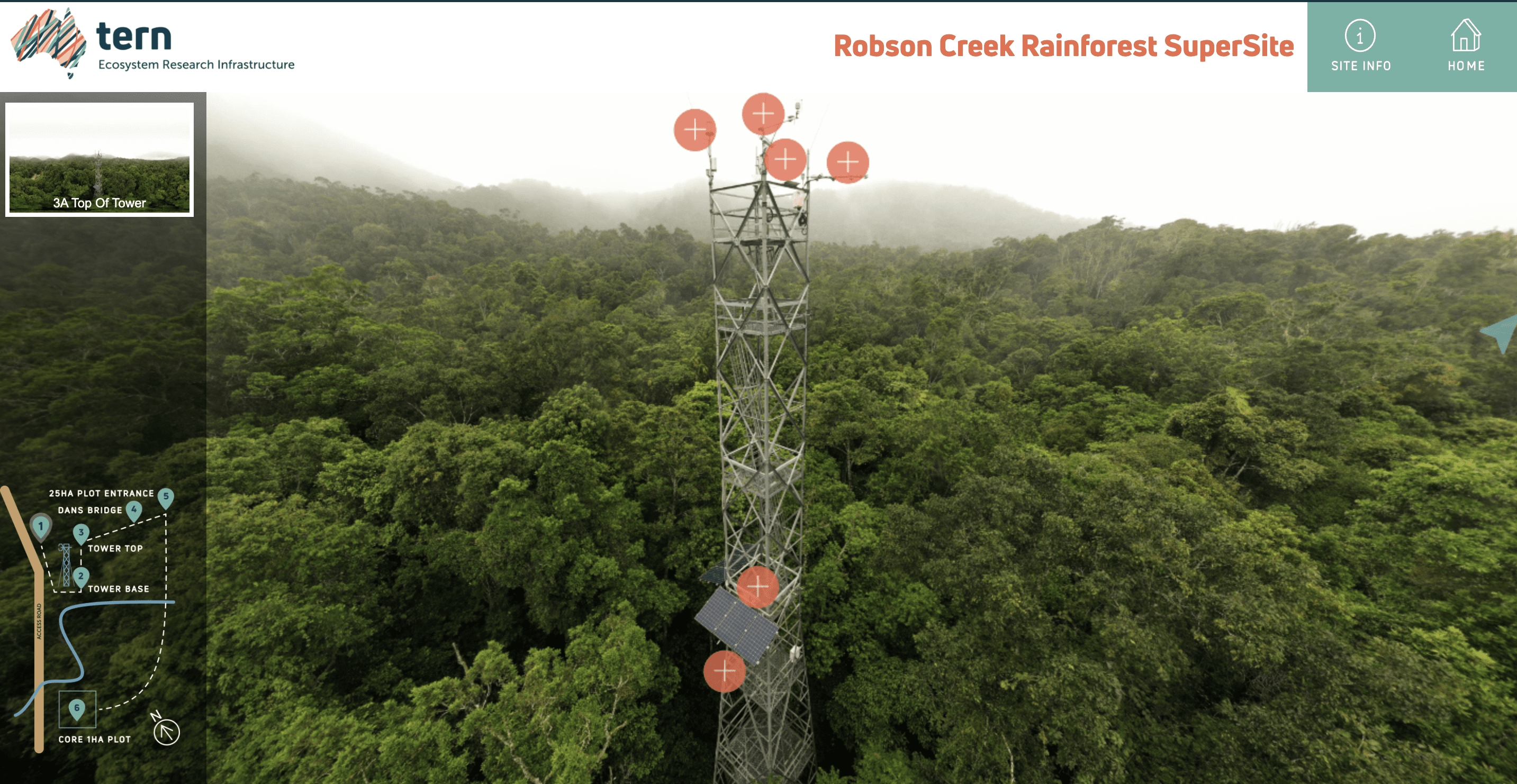Take a virtual tour of TERN’s environmental monitoring site in the rainforests of Yidinji land in Far North Queensland. Learn about the sensors, cameras and surveys used to monitor the ecosystem, its plants, animals and processes, providing data for researchers around the world.
Even with travel opening up, it is probably not feasible to visit all of Australia’s beautiful ecosystems in person. The next best thing is to take a tour with your computer screen, smart phone or tablet.
So, grab a cuppa, get comfy in front of your device, and join us on an armchair tour of TERN’s Robson Creek Rainforest Supersite, located on Yidinji land in far north Queensland, not far from Atherton.
Take the tour
Facilitating world-leading rainforest research
Since 2009, TERN and its site partners, James Cook University (JCU), CSIRO and the Queensland Government, have been collecting biological and environmental data at the site using field surveys, autonomous monitoring sensors and remote-sensing technologies such as drones and satellites.
TERN makes these data openly available, together with data and samples from >800 other TERN sites, to facilitate Australia’s world-leading research on climate change, biodiversity, water and soil.
For example, data collected at TERN’s Robson Creek Rainforest SuperSite are being used to calibrate and validate carbon models and in greenhouse gas accounting, to understand forest vulnerability to drought, ecosystem tipping points and landscape-scale biodiversity, and to monitor and predict extreme events in Australia.
It is also used by JCU to educate, train and support the next generation of Australia’s ecosystem scientists.
The site is in the top 55 global sites for the calibration and validation of satellite-derived global bio-geophysical data products (international Committee on Earth Observation Satellites CEOS), and part of the International Long-Term Ecological Research Network (ILTER) and the Smithsonian Tropical Research Institute’s Center for Tropical Forest Science’s Forest Global Earth Observatory (CTFS-ForestGEO).
Site Infrastructure & Characteristics

SuperSite Research Infrastructure
- Eddy-covariance flux tower
- 1 ha core plot
- 25 ha forest dynamics plot
- Weather station
- Acoustic sensors (5)
- Phenocams (3 above canopy)
- Sap flow system
- Soil water content, soil water potential, soil temperature sensors
- COSMOS soil moisture sensor
- Airborne LiDAR and hyperspectral datasets calibrated using SLATS star transects, leaf sampling, tree structure and LAI measurements

SuperSite Details
- Vegetation type: Simple Notophyll Vine Forest
- Elevation: ~700 m
- Rainfall: ~2236 mm/yr
- Mean Temperature: ~19.4°C
- Soils: Acidic, dystrophic, brown dermosol, developed in alluvium
TERN’s Robson Creek Rainforest SuperSite is well equipped with a huge variety of monitoring devices to measure ecosystem change at the ecosystem and we welcome co-use of the site by researchers
Explore the rainforest
When you start the tour, you will be joined by one of our scientists, Associate Professor Mike Liddell of JCU. Mike will introduce you to the site and invite you to ‘walk around’ and explore its flora and fauna and the national research infrastructure collecting the data.
There are six locations on the tour with each location having several scenes to tour. You can click on items of interest around the scenes, which include photos, diagrams, videos and eco-acoustic recordings.
To move to the next scene, click on a thumbnail image on the left of the screen, use the green arrow markers within the scene or click a number on the site map to ‘walk’ to the next location.
At several locations, you will be joined by Mike or CSIRO’s Matt Bradford for short video introductions to the key features (natural or infrastructure) at that location.
If you have any questions about how to use the tour, please don’t hesitate to contact us. We’d also love to get your feedback before the release of our forthcoming virtual tour of TERN’s Alice Mulga SuperSite in the Northern Territory.







